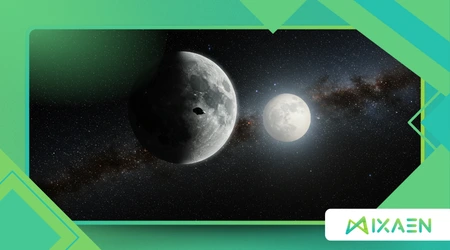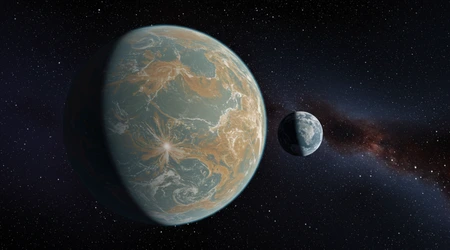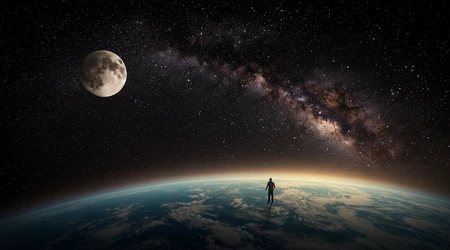The Goldilocks Zone: Why It’s Not the Only Place Life Could Exist

The Goldilocks Zone, that sweet spot around a star where liquid water might exist, has long captivated scientists and dreamers alike.
Anúncios
It’s the region not too hot, not too cold where conditions seem just right for life as we know it. But is this zone the only place where life could thrive?
Recent discoveries and evolving theories suggest otherwise, pushing the boundaries of astrobiology beyond this narrow band.
From subsurface oceans to exotic atmospheres, the search for extraterrestrial life is expanding, driven by cutting-edge research and a willingness to rethink what makes a planet habitable.
This article dives into why the Goldilocks Zone isn’t the full story, exploring new frontiers in the quest for life among the stars.
Anúncios
Why does the Goldilocks Zone hold such allure? It stems from Earth’s own story our planet orbits the Sun at a distance where liquid water, the cornerstone of life, remains stable.
Yet, as we uncover more about exoplanets and our own solar system, the idea that life hinges solely on this zone feels restrictive.
Planets and moons far outside this region, from icy Europa to scorching Venus, hint at possibilities we can’t ignore.
By blending 2025 research with fresh perspectives, we’ll unpack why habitability is more complex than a single orbital sweet spot, offering a richer view of where life might flourish.
This exploration isn’t just academic it’s a call to rethink our place in the cosmos. What if life doesn’t need a Goldilocks Zone at all? Could alien worlds defy our Earth-centric biases?
Let’s venture beyond the familiar to uncover the surprising places where life might take hold, grounded in real science and bold ideas.
The Traditional View of the Goldilocks Zone
The Goldilocks Zone defines a star’s orbital range where temperatures allow liquid water on a planet’s surface. It’s a simple, elegant concept rooted in Earth’s blueprint.
Our planet thrives because it sits at just the right distance from the Sun about 150 million kilometers where water doesn’t freeze or boil away.
This idea, formalized by James Kasting in 1993, became a cornerstone of astrobiology, guiding the search for habitable exoplanets.
++ How Astronomers Detect Planets They Can’t Even Se
Yet, this focus on surface water overlooks other factors. Atmospheres, magnetic fields, and geological activity all shape habitability.
Venus, within our Sun’s Goldilocks Zone, is a fiery hellscape due to its runaway greenhouse effect. Mars, also in the zone, is a cold desert. Clearly, distance alone doesn’t guarantee life-friendly conditions.
Consider the star type, too. Hotter stars have wider habitable zones, while dimmer red dwarfs have tighter ones, often exposing planets to intense radiation.
The Goldilocks Zone varies, and its boundaries aren’t fixed. This variability challenges the notion that it’s the sole arbiter of life’s potential.

Beyond Surface Water: Subsurface Oceans
Some of the most promising candidates for life lie far outside the Goldilocks Zone. Take Europa, Jupiter’s icy moon.
Its surface is frozen, but beneath lies a vast ocean, kept liquid by tidal heating from Jupiter’s gravitational pull. This hidden sea could harbor microbial life, defying traditional habitability models.
Enceladus, Saturn’s moon, tells a similar story. Geysers spew water from its subsurface ocean, hinting at chemical energy sources like hydrothermal vents.
These environments mirror Earth’s deep-sea ecosystems, where life thrives without sunlight. Such discoveries expand our view of where life might exist.
Also read: Could Alien Life Be Based on Something Other Than Carbon?
Ceres, a dwarf planet in our asteroid belt, may also host subsurface water. Recent studies suggest briny reservoirs beneath its icy crust, potentially rich in organic compounds.
These examples show that liquid water and possibly life doesn’t need a star’s perfect distance to persist.
Exotic Atmospheres and Alternative Chemistries
Atmospheres can make or break a planet’s habitability, regardless of its orbit. Consider Venus, once potentially habitable but now scorched by a thick, CO2-heavy atmosphere.
Recent 2025 studies suggest its clouds might still host microbial life, adapted to extreme acidity. This challenges the idea that life requires Earth-like conditions.
Exoplanet K2-18b, orbiting a red dwarf, offers another twist. Located outside the traditional Goldilocks Zone, it may have water vapor in its atmosphere, hinting at potential habitability.
Its star’s radiation could drive unique chemical cycles, fostering life unlike anything on Earth.
Then there’s Titan, Saturn’s moon, with lakes of liquid methane. Could life use methane instead of water as a solvent?
Read more: What the Discovery of Earth-Like Planets Means for Humanity
This speculative chemistry, backed by lab experiments, suggests life might not need water at all, broadening our search parameters dramatically.
The Role of Energy and Geological Activity
Life needs energy, not just water. Earth’s ecosystems rely on sunlight or chemical energy from volcanic activity. Exoplanets outside the Goldilocks Zone could tap alternative sources.
For instance, rogue planets free-floating, untethered to stars might sustain life via geothermal heat from radioactive decay.
Imagine a rogue planet, drifting in the cosmic void, its core still warm from formation. Subsurface oceans, heated by geological processes, could host microbial colonies. This scenario, explored in 2025 models, shows life doesn’t always need a star’s warmth.
Geological activity also matters. Plate tectonics on Earth recycles nutrients and stabilizes climate.
Exoplanets with similar processes, even far from their star’s habitable zone, might support life by maintaining dynamic, energy-rich environments.
Redefining Habitability: A Broader Perspective
The Goldilocks Zone is a starting point, not a rulebook. A 2024 study by Amri Wandel suggests planets around M-dwarf stars could harbor liquid water beneath glaciers, far outside traditional habitable zones. This expands the estimated number of potentially habitable worlds by billions.
This shift demands a broader definition of habitability. Factors like atmospheric composition, magnetic fields, and internal heat sources are as critical as orbital distance. Life might thrive in unexpected places, from icy moons to gas giants’ moons.
Consider an analogy: searching for life only in the Goldilocks Zone is like fishing only in a pond’s sunny shallows, ignoring the deep, murky waters teeming with strange creatures. Our search must dive deeper, embracing the universe’s complexity.
Table: Comparing Habitability Factors Across Celestial Bodies
| Body | Orbit in Goldilocks Zone? | Liquid Water? | Energy Source | Potential for Life? |
|---|---|---|---|---|
| Earth | Yes | Surface oceans | Sunlight, geothermal | Confirmed |
| Europa | No | Subsurface ocean | Tidal heating | Possible |
| Venus | Yes | Possible in clouds | Solar, chemical | Speculative |
| K2-18b | No | Atmospheric vapor | Stellar, chemical | Possible |
| Titan | No | Methane lakes | Chemical, geothermal | Speculative |
Original Examples of Life Beyond the Goldilocks Zone
Example 1: The Drifting Oasis
Picture a rogue planet, ejected from its star system billions of years ago. Its core, still radioactive, generates heat, keeping a subsurface ocean liquid.
Microbial life, feeding on chemical gradients near hydrothermal vents, thrives in this dark, starless world. Such a planet, discovered in 2025 surveys, could redefine habitability.
Example 2: The Cloud Dwellers
Imagine an exoplanet orbiting a red dwarf, too close for surface water but with a thick atmosphere. High in its clouds, microbes float, using ultraviolet radiation to drive metabolic processes.
This scenario, inspired by Venus research, suggests life could adapt to extreme aerial environments.
The Future of the Search for Life

The hunt for life is evolving with technology. The James Webb Space Telescope, in 2025, is analyzing exoplanet atmospheres for biosignatures like methane and oxygen.
These clues could reveal life on worlds far from the Goldilocks Zone, challenging old assumptions.
Future missions, like the Habitable Worlds Observatory, aim to study Earth-like exoplanets directly. They’ll focus on diverse worlds, not just those in traditional habitable zones.
This shift reflects a growing consensus that life’s requirements are more flexible than once thought.
Citizen science also plays a role. Volunteers analyzing Kepler data have identified thousands of exoplanets, some with unexpected traits.
This collaborative effort underscores the need for open-minded exploration beyond conventional boundaries.
Why the Goldilocks Zone Still Matters
Despite its limitations, the Goldilocks Zone remains a useful guide. It’s where we’re most likely to find Earth-like planets with familiar conditions.
Kepler’s 2013 discovery of Kepler-69c, an Earth-sized planet in its star’s habitable zone, sparked hope for such worlds.
Yet, clinging too tightly to this model risks missing the universe’s diversity. Life might not need Earth’s exact conditions.
By balancing the Goldilocks Zone’s focus with broader criteria, we maximize our chances of finding alien life.
The zone’s simplicity also aids public engagement. It’s an accessible concept, sparking curiosity about exoplanets.
But as science advances, we must communicate that habitability is multifaceted, not confined to a single orbital band.
Conclusion: Embracing a Cosmic Perspective
The Goldilocks Zone has shaped our search for life, offering a clear starting point. Yet, it’s not the whole story.
From Europa’s hidden oceans to Titan’s methane lakes, the universe teems with possibilities that defy this narrow framework.
By expanding our view considering subsurface environments, exotic chemistries, and alternative energy sources we open new doors in the quest for extraterrestrial life.
A 2024 statistic estimates 22% of solar-type stars host Earth-sized planets in their habitable zones, but billions more worlds outside these zones could harbor life.
This journey challenges us to let go of Earth-centric biases. Life might not need a perfect orbital distance or even water. It could lurk in the clouds of a scorching planet or the depths of a starless world.
As we push the boundaries of astrobiology in 2025, we’re not just searching for life we’re redefining what it means to be alive. So, what’s next?
Will we find life in the most unexpected corners of the cosmos? The answer lies in our willingness to explore beyond the Goldilocks Zone.
Frequently Asked Questions
1. What is the Goldilocks Zone?
It’s the region around a star where temperatures allow liquid water on a planet’s surface, often called the habitable zone.
2. Can life exist outside the Goldilocks Zone?
Yes, places like Europa’s subsurface oceans and Titan’s methane lakes suggest life could thrive in diverse environments.
3. Why is liquid water important for life?
Water is a solvent for biochemical reactions, essential for life as we know it, though other solvents like methane are possible.
4. How do scientists search for life beyond the Goldilocks Zone?
They use telescopes like James Webb to detect biosignatures and study atmospheres, plus explore moons with subsurface oceans.
5. What’s a rogue planet, and could it support life?
A rogue planet drifts without a star. Geothermal heat could sustain subsurface oceans, potentially hosting microbial life.
